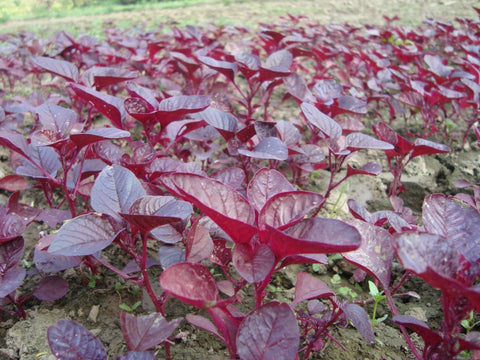How to increase blood circulation to the brain naturally
Learning how to increase blood circulation to the brain naturally is not just done for cognitive function but also overall health. According to a 2009 study published by Morgan & Claypool Life Sciences, the brain uses 20% of available oxygen to function, making cerebral blood flow and oxygen delivery critical for survival.
For blood flow to increase to various brain areas, upstream vessels dilate to avoid reductions in downstream microvascular pressure. When this process is disrupted, the amount of blood circulation to the brain can decrease. Figuring out how to increase blood circulation to the brain can be as simple as making small dietary changes to include cognition-supporting foods.
Nitrate-rich vegetables help stimulate nitric oxide (NO) production, a vital signaling molecule in the body that helps support brain and vascular health. Eating these foods daily or adding a red spinach supplement or a beetroot supplement to boost nitric oxide are great ways to naturally increase and maintain health and circulation.
Here are nine foods that help support increased blood flow to the brain that may also improve cognitive function.
How to Increase Blood Circulation to the Brain with Nutrition: 9 Foods That Support Cognitive Health
1. Beets and Beetroot
Beets are famous for their potent nitric oxide boosting properties. Elite and aging athletes often use beetroot juice to increase endurance during strenuous exercise. However, beets are also praised as multi-beneficial vegetables.
A 2015 study from Northumbria University investigated the influence of beetroot on nitric oxide in the brain. Research showed that cognitive function declines with age primarily due to reduced blood flow. Older adults were administered either beetroot juice or a nitrate-depleted diet during the study.
MRI results revealed that the high-nitrate diet stimulated an increase in frontal cortex perfusion, the area of the brain responsible for executive function, working memory, and task-switching. An additional 2013 study from Howard University supported these conclusions, with participants showing increased cerebral blood flow after a single serving of nitrate-rich beetroot juice.
2. Red Spinach
Red spinach is another one of nature’s premier nitric oxide boosters. Its high level of nitrates makes red spinach an excellent option for anyone looking to increase nitric oxide levels. A 2015 study from the University of Exeter found that dietary nitrate enhances repeated sprint performance and slows the decline of cognitive function/reaction time during strenuous exercise. Due to the influence on blood flow, nitrate-rich red spinach may improve physical and cognitive performance.
3. Tart Cherry
Tart cherry is a muscle and joint-loving fruit that gets its red pigment from anthocyanin. Tart cherry helps body movement and flexibility and provides another option for people to learn how to increase blood circulation to the brain.
According to scientists from the University of Delaware, drinking tart red cherry juice every day may help boost cognition and brain health in older adults. The study investigated the influence of dietary anthocyanins on brain function, speculating that improvement may be associated with increases in nitric oxide synthase.
4. Pomegranate

Pomegranate is known for its antioxidants, exceeding the levels found in green tea and red wine. Alongside antioxidants, pomegranate also contains amino acids, polyphenols, catechins, and flavonoids. While pomegranate contains a small level of nitrates, they are known for their nitric oxide protecting abilities.
Pomegranate is a supportive fruit to add to a nitrate-rich diet to support healthy nitric oxide levels. Researchers from the University of California found that participants that drank pomegranate juice experienced improved verbal memory scores and plasma antioxidant levels. The study suggests that pomegranate juice may help boost blood flow to task-related areas of the brain.
5. Citrus Fruits
Citrus fruits like oranges are a natural source of vitamin C, antioxidants, and flavonoids. Vitamin C helps boost nitric oxide production by helping the body rid itself of harmful free radicals. According to a 2015 study from the University of Reading, older adults drinking orange juice for eight weeks saw improved memory, reaction time, and verbal fluency. When researching how to increase blood circulation to the brain naturally, they found that a glass of orange juice in the morning may benefit cognitive function.
6. Walnuts and Foods Rich in Omega-3 Fatty Acids
A 2008 study from the UCLA School of Medicine revealed that omega-three fatty acids are among the best-studied interactions between food and brain evolution. Docosahexaenoic acid (DHA) is the most abundant omega-three fatty acid in brain cell membranes.
The body isn’t efficient at synthesizing DHA, making dietary DHA a vital part of balanced brain nutrition. When focusing on how to increase blood flow to the brain efficiently, it should be noted that this efficiency is linked to omega-3 fatty acids. Plant-based sources like walnuts, kiwi fruit, chia, butternuts, and flax seeds are excellent sources that support brain health.
7. Berries
Berries like blueberry are nitric oxide protective and are rich in anthocyanins. Researchers from Swinburne University of Technology found that blueberry consumption may increase blood flow to task-related areas of the brain. The results are improvements in short-term, long-term, and spatial memory.
8. Cinnamon
Cinnamon contains phytochemicals that boost the brain's ability to utilize glucose. A 2021 study on mice found that cinnamon extract reduces the effects of neuronal loss after traumatic brain injury (TBI). These findings have sparked new investigations into cinnamon’s impact on cognitive function and memory loss in humans after TBI. With additional research, cinnamon may also offer solutions for how to increase blood flow to the brain.
9. Leafy Greens

Leafy greens are some of the most ubiquitous brain foods. Super greens like arugula, kale, and mustard greens can boost nitric oxide. The answer to how to increase blood circulation to the brain naturally starts with balanced nutrition. Eating a diet rich in leafy greens has been shown to support cognitive function.
A 2017 study from the Memory and Aging Project found that participants who consumed 1-2 servings of leafy greens daily had improved memory and less cognitive decline than those who ate less.
How to Increase Blood Flow to the Brain
One great solution for how to increase blood flow to the brain begins with diet. Nitrate-rich vegetables boost nitric oxide levels that may support blood flow and cognitive function. Further, diversifying whole food nutrients in the diet will target brain-loving macro and micronutrients that help support circulation. Overall, these nine foods are an excellent place to start when looking to increase circulation to the brain.
References
Cipolla MJ. The Cerebral Circulation. San Rafael (CA): Morgan & Claypool Life Sciences; 2009. Chapter 5, Control of Cerebral Blood Flow. Available from: https://www.ncbi.nlm.nih.gov/books/NBK53082/
Bond V Jr, Curry BH, Adams RG, Asadi MS, Millis RM, Haddad GE. Effects of dietary nitrates on systemic and cerebrovascular hemodynamics. Cardiol Res Pract. 2013;2013:435629. doi: 10.1155/2013/435629. Epub 2013 Dec 25. PMID: 24455404; PMCID: PMC3886243.
Gómez-Pinilla F. Brain foods: the effects of nutrients on brain function. Nat Rev Neurosci. 2008;9(7):568-578. doi:10.1038/nrn2421
Thompson C, Wylie LJ, Fulford J, Kelly J, Black MI, McDonagh ST, Jeukendrup AE, Vanhatalo A, Jones AM. Dietary nitrate improves sprint performance and cognitive function during prolonged intermittent exercise. Eur J Appl Physiol. 2015 Sep;115(9):1825-34. doi: 10.1007/s00421-015-3166-0. Epub 2015 Apr 7. PMID: 25846114.
Thompson C, Wylie LJ, Fulford J, Kelly J, Black MI, McDonagh ST, Jeukendrup AE, Vanhatalo A, Jones AM. Dietary nitrate improves sprint performance and cognitive function during prolonged intermittent exercise. Eur J Appl Physiol. 2015 Sep;115(9):1825-34. doi: 10.1007/s00421-015-3166-0. Epub 2015 Apr 7. PMID: 25846114.
Bookheimer SY, Renner BA, Ekstrom A, Li Z, Henning SM, Brown JA, Jones M, Moody T, Small GW. Pomegranate juice augments memory and FMRI activity in middle-aged and older adults with mild memory complaints. Evid Based Complement Alternat Med. 2013;2013:946298. doi: 10.1155/2013/946298. Epub 2013 Jul 22. PMID: 23970941; PMCID: PMC3736548.
Travica N, D'Cunha NM, Naumovski N, Kent K, Mellor DD, Firth J, Georgousopoulou EN, Dean OM, Loughman A, Jacka F, Marx W. The effect of blueberry interventions on cognitive performance and mood: A systematic review of randomized controlled trials. Brain Behav Immun. 2020 Mar;85:96-105. doi: 10.1016/j.bbi.2019.04.001. Epub 2019 Apr 15. PMID: 30999017.
Kawatra P, Rajagopalan R. Cinnamon: Mystic powers of a minute ingredient. Pharmacognosy Res. 2015;7(Suppl 1):S1-S6. doi:10.4103/0974-8490.157990
Qubty D, Rubovitch V, Benromano T, Ovadia M, Pick CG. Orally Administered Cinnamon Extract Attenuates Cognitive and Neuronal Deficits Following Traumatic Brain Injury. J Mol Neurosci. 2021 Jan;71(1):178-186. doi: 10.1007/s12031-020-01688-4. Epub 2020 Sep 8. PMID: 32901372.






Comments (0)
There are no comments for this article. Be the first one to leave a message!